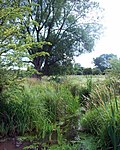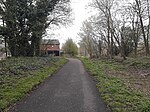Clayhanger Marsh
Sites of Special Scientific Interest in the West Midlands (county)Sites of Special Scientific Interest notified in 1986
Clayhanger Marsh is a 23.8 hectare (58.8 acre) biological site of Special Scientific Interest in the West Midlands. The site was notified in 1986 under the Wildlife and Countryside Act 1981. It is located to the north of Walsall. The first vagrant bufflehead recorded in the West Midlands county was found here in June 2004.
Excerpt from the Wikipedia article Clayhanger Marsh (License: CC BY-SA 3.0, Authors).Clayhanger Marsh
McClean Way,
Geographical coordinates (GPS) Address Nearby Places Show on map
Geographical coordinates (GPS)
| Latitude | Longitude |
|---|---|
| N 52.63824 ° | E -1.95119 ° |
Address
Pit Mound
McClean Way
WS3 4PX , High Heath
England, United Kingdom
Open on Google Maps









